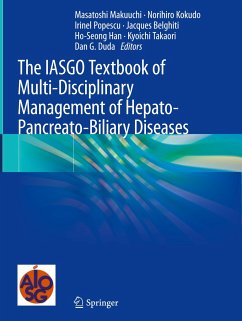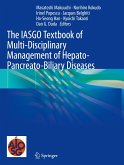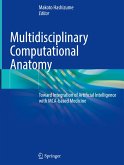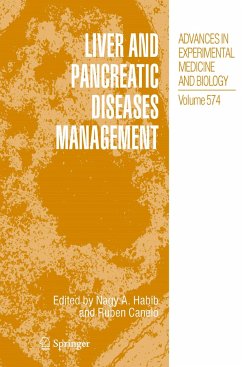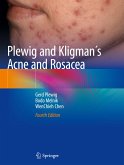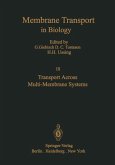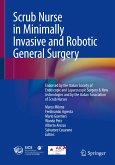The IASGO Textbook of Multi-Disciplinary Management of Hepato-Pancreato-Biliary Diseases
Herausgegeben:Makuuchi, Masatoshi; Kokudo, Norihiro; Popescu, Irinel; Belghiti, Jacques; Han, Ho-Seong; Takaori, Kyoichi; Duda, Dan G.
The IASGO Textbook of Multi-Disciplinary Management of Hepato-Pancreato-Biliary Diseases
Herausgegeben:Makuuchi, Masatoshi; Kokudo, Norihiro; Popescu, Irinel; Belghiti, Jacques; Han, Ho-Seong; Takaori, Kyoichi; Duda, Dan G.
- Gebundenes Buch
- Merkliste
- Auf die Merkliste
- Bewerten Bewerten
- Teilen
- Produkt teilen
- Produkterinnerung
- Produkterinnerung
This textbook includes 70 chapters contributed by an exceptional group of experts in all areas of hepato-pancreato-biliary diseases, bringing a multi-disciplinary approach to treatments. The book is designed to cover all aspects of the liver and pancreatic anatomy and pathology, as well as therapy. The topics are comprehensively reviewed, and as well as summarizing the previous works, the authors provide discussions of practice-changing techniques and approaches to therapy of HBP cancers. Treating the diseases in hepato-pancreato-biliary regions is particularly difficult due to the complex…mehr
Andere Kunden interessierten sich auch für
![The IASGO Textbook of Multi-Disciplinary Management of Hepato-Pancreato-Biliary Diseases The IASGO Textbook of Multi-Disciplinary Management of Hepato-Pancreato-Biliary Diseases]() The IASGO Textbook of Multi-Disciplinary Management of Hepato-Pancreato-Biliary Diseases81,99 €
The IASGO Textbook of Multi-Disciplinary Management of Hepato-Pancreato-Biliary Diseases81,99 €![Multidisciplinary Computational Anatomy Multidisciplinary Computational Anatomy]() Multidisciplinary Computational Anatomy65,99 €
Multidisciplinary Computational Anatomy65,99 €![Multidisciplinary Computational Anatomy Multidisciplinary Computational Anatomy]() Multidisciplinary Computational Anatomy89,99 €
Multidisciplinary Computational Anatomy89,99 €![Liver and Pancreatic Diseases Management Liver and Pancreatic Diseases Management]() Liver and Pancreatic Diseases Management161,99 €
Liver and Pancreatic Diseases Management161,99 €![Plewig and Kligman´s Acne and Rosacea Plewig and Kligman´s Acne and Rosacea]() Gerd PlewigPlewig and Kligman´s Acne and Rosacea186,99 €
Gerd PlewigPlewig and Kligman´s Acne and Rosacea186,99 €![Transport Across Multi-Membrane Systems Transport Across Multi-Membrane Systems]() Transport Across Multi-Membrane Systems83,99 €
Transport Across Multi-Membrane Systems83,99 €![Scrub Nurse in Minimally Invasive and Robotic General Surgery Scrub Nurse in Minimally Invasive and Robotic General Surgery]() Scrub Nurse in Minimally Invasive and Robotic General Surgery89,99 €
Scrub Nurse in Minimally Invasive and Robotic General Surgery89,99 €-
-
-
This textbook includes 70 chapters contributed by an exceptional group of experts in all areas of hepato-pancreato-biliary diseases, bringing a multi-disciplinary approach to treatments. The book is designed to cover all aspects of the liver and pancreatic anatomy and pathology, as well as therapy. The topics are comprehensively reviewed, and as well as summarizing the previous works, the authors provide discussions of practice-changing techniques and approaches to therapy of HBP cancers. Treating the diseases in hepato-pancreato-biliary regions is particularly difficult due to the complex anatomy, aggressive biological behavior, and poor prognosis. Therefore, ample illustrations are included to tackle these challenges.
The IASGO Textbook of Multi-Disciplinary Management of Hepato-Pancreato-Biliary Diseases aims to update the academic and non-academic medical professionals, such as surgeons, radiation oncologists, medical oncologists, gastroenterologists, interventional radiologists, radiologists, basic scientists. In collaboration with the International Association of Surgeons, Gastroenterologists and Oncologists (IASGO), delivers a valuable and well-organized textbook for medical professionals.
The IASGO Textbook of Multi-Disciplinary Management of Hepato-Pancreato-Biliary Diseases aims to update the academic and non-academic medical professionals, such as surgeons, radiation oncologists, medical oncologists, gastroenterologists, interventional radiologists, radiologists, basic scientists. In collaboration with the International Association of Surgeons, Gastroenterologists and Oncologists (IASGO), delivers a valuable and well-organized textbook for medical professionals.
Produktdetails
- Produktdetails
- Verlag: Springer / Springer Nature Singapore / Springer, Berlin
- Artikelnr. des Verlages: 978-981-19-0062-4
- 1st edition 2022
- Seitenzahl: 576
- Erscheinungstermin: 4. Juni 2022
- Englisch
- Abmessung: 285mm x 215mm x 35mm
- Gewicht: 1808g
- ISBN-13: 9789811900624
- ISBN-10: 9811900620
- Artikelnr.: 63284696
- Herstellerkennzeichnung Die Herstellerinformationen sind derzeit nicht verfügbar.
- Verlag: Springer / Springer Nature Singapore / Springer, Berlin
- Artikelnr. des Verlages: 978-981-19-0062-4
- 1st edition 2022
- Seitenzahl: 576
- Erscheinungstermin: 4. Juni 2022
- Englisch
- Abmessung: 285mm x 215mm x 35mm
- Gewicht: 1808g
- ISBN-13: 9789811900624
- ISBN-10: 9811900620
- Artikelnr.: 63284696
- Herstellerkennzeichnung Die Herstellerinformationen sind derzeit nicht verfügbar.
This Textbook is published in collaboration with the International Association of Surgeons, Gastroenterologists and Oncologists (IASGO). ¿Dr. Masatoshi Makuuchi served as Professor and Chairman for both Hepatobiliary Pancreatic Surgery Division and Artificial Organ and Transplantation Surgery Division, University of Tokyo, Japan, and is the President of the IASGO. He has pioneered multiple techniques in liver surgery. Dr. Norihiro Kokudo served as Professor and Chairman for both Hepatobiliary Pancreatic Surgery Division and Artificial Organ and Transplantation Surgery Division at The University of Tokyo Hospital, Japan. He is now the President of the National Center for Global Health and Medicine and IASGO VicePresident, and a leader in the field of liver cancer treatment. Dr. Irinel Popescu led the Department of Surgery and Liver Transplantation at the Fundeni Clinical Institute in Romania. He was elected as a corresponding member of the Romanian Academy. He introduced liver transplantation in Romania and performed more than 1,000 liver transplantations. He serves as the VicePresident of IASGO. Dr. Jacques Belghiti was the Head of the HepatoBilioPancreatic Surgery and Liver Transplantation department in Beaujon Hospital, University of Paris. In 2014 he was nominated by the President of France to the board of the High Authority for Health. Professor Belghiti's has produced important studies in the surgical techniques of liver resection and hepatöpancreatöbiliary surgical oncology. He serves as the VicePresident of IASGO. Dr. Ho-Seong Han is a Professor at the Seoul National University Hospital and Chairman of Department of Surgery at the Seoul National University Bundang Hospital, Korea. He is a pioneer in minimally invasive surgery in the field of hepatöpancreatöbiliary surgery and has performed more than 1,000 laparoscopic liver surgeries. He serves as teh Treasurer of the IASGO. Dr. Kyoicihi Takaori was the Director of the Pancreatic Cancer Unit, Kyoto University Hospital Cancer Center, Japan. He has made important contributions to pancreatic cancer surgery techniques, robotic surgery, multimodality management of pancreatic cancer, and screening for pancreatic cancer. He serves as Secretary General of IASGO. Dr. Dan G. Duda is the Director of Translational Research in Gastrointestinal Radiation Oncology at Massachusetts General Hospital and Harvard Medical School, Boston, USA. He is an expert in combinatorial strategies for liver and pancreatic malignancies, and is Secretary General of IASGO.
1. Surgical anatomy of the liver.- 2.Surgical anatomy of the pancreas.- 3. Surgical anatomy of the biliary tract.- 4. Liver function and posthepatectomy liver failure.- 5. Surgical approach to Pancreas, Liver, Biliary Physiologic Impairment.- 6. Biliary tract functions and impairment.- 7. Preinvasive intraductal biliary neoplasm: Biliary intraepithelial biliary neoplasm and intraductal papillary neoplasm of bile duct.- 8. Pathology of biliary tract cancers.- 9. Multifocal hepatocellular carcinoma: Genomic and transcriptional heterogeneity.- 10. Intraductal neoplasms of the pancreas.- 11. Mucinous cystic neoplasms (MCNs). -12. Pathology of Pancreatic Cancer.- 13. CT in Hepato-Bilio-Pancreatic Surgical Pathology.- 14. Magnetic Resonance Elastography (MRE) to assess hepatic fibrosis.- 15. FDG-PET for management on Hepato-pancreato-biliary disease.- 16. Endoscopic ultrasound for hepato-pancreato-biliary diseases.- 17. Intraoperative imaging techniques in liver surgery.- 18. Scientific rationale for combination therapies in HPB malignancies Use of radiotherapy alone and in combination with other therapies for hepatocellular carcinoma: Rationale and future directions.- 19. Recent update in chemotherapy of Cholangiocarcinoma.- 20. Chemotherapy in pancreatic ductal adenocarcinoma.- 21. Immune-checkpoint inhibitors in hepatocellular carcinoma.- 22. Molecularly targeted therapy in cholangiocarcinoma.- 23. Systemic therapies in pancreatic cancers.- 24. Endoscopic Biliary Drainage and Associated Procedures Required for Patients with Malignant Biliary Strictures.- 25. Endoscopic management of peripancreatic fluid collection.- 26. Endoscopic ultrasound and fine needle tissue acquisition for pancreatic tumors.- 27. Concept and purpose of ERAS.- 28. Multidisciplinary Enhanced Recovery After Surgery (ERAS) pathway for hepatobiliary and pancreatic surgery.- 29. ERAS for pancreatic surgery.- 30.Ultrasound-guided anatomic resection of the liver.- 31. Parenchyma-sparing hepatic resection for multiple metastatic tumors.- 32. Open and laparoscopic liver hanging maneuver.- 33. The Glissonean pedicle approach: The Takasaki Technique.- 34. Laparoscopic Major Hepatectomy and Parenchymal-Sparing Anatomical Hepatectomy.- 35. Laparoscopic anatomical resection of the liver: Segmentectomy and Sub-segmentectomy.- 36. Modified ALPPS procedure.- 37. Artery-first approach in pancreaticoduodenectomy.- 38. Organ and parenchyma sparing pancreatic surgery.- 39. Isolated pancreatoduodenectomy with portal vein resection using the Nakao mesenteric approach.- 40. Pancreaticoduodenectomy with hepatic artery resection.- 41. Pancreaticoduodenectomy with splenic artery resection for tumors of the pancreatic head and/or body invading the splenic artery.- 42. Pancreaticoduodenectomy with superior mesenteric resection and reconstruction for locally advanced tumors.- 43. Robotic Pancreaticoduodenectomy.- 44. Duodenum-Preserving Pancreatic Head Resection.- 45. Artery-first approaches to distal pancreatectomy.- 46. Spleen-preserving distal pancreatectomy.- 47. Distal pancreatectomy with en bloc celiac axis resection (DP-CAR).- 48. Modified Distal Pancreatectomy with Celiac Axis En-bloc Resection (modified DP-CAR).- 49. Robotic distal pancreatectomy.- 50. Pancreaticoduodenectomy with superior mesenteric resection and reconstruction for locally advanced tumors.- 51. Pancreatic resection for solid pseudopapillary neoplasms.- 52. Pancreatic resection for neuroendocrine neoplasms of the pancreas.- 53. International Consensus Guidelines for the management of intraductal papillary mucinous neoplasms.- 54. Remnant pancreatic cancer after surgical resection for pancreatic cancer.- 55. Benign Biliary Diseases.- 56. Major hepatic resectionfor perihilar biliary cancers.- 57. Surgical Management of Intrahepatic Cholangiocarcinoma.- 58. Hepatopancreatoduodenectomy (HPD) for biliary tract cancers.- 59. Hepato-biliary injuries.- 60. Surgical treatment for severe liver injuries.- 61. Indications for liver transplantation in adults - selection of patients with end stage liver diseases.- 62. Indications for liver transplantation in Acute liver failure.- 63. Liver Graft Retrieval in Deceased Donors.- 64. Deceased donor liver transplantation: the pendulum of visions and ideas.- 65. Living donor liver transplantation.- 66. Pyogenic Liver Abscess.- 67. Liver transplantation for Colorectal and Neuroendocrine Liver Metastases and Hepatoblastoma.- 68. Technical variant liver transplantation: split, dual graft, and auxiliary transplantation.- 69. Domino liver transplantation.- 70. Allogeneic and Autologous Pancreatic Islet Cell Transplantation.- 71. IASGOchapterKaramarkovic_totalpancreatectomy edit.
1. Surgical anatomy of the liver.- 2.Surgical anatomy of the pancreas.- 3. Surgical anatomy of the biliary tract.- 4. Liver function and posthepatectomy liver failure.- 5. Surgical approach to Pancreas, Liver, Biliary Physiologic Impairment.- 6. Biliary tract functions and impairment.- 7. Preinvasive intraductal biliary neoplasm: Biliary intraepithelial biliary neoplasm and intraductal papillary neoplasm of bile duct.- 8. Pathology of biliary tract cancers.- 9. Multifocal hepatocellular carcinoma: Genomic and transcriptional heterogeneity.- 10. Intraductal neoplasms of the pancreas.- 11. Mucinous cystic neoplasms (MCNs). -12. Pathology of Pancreatic Cancer.- 13. CT in Hepato-Bilio-Pancreatic Surgical Pathology.- 14. Magnetic Resonance Elastography (MRE) to assess hepatic fibrosis.- 15. FDG-PET for management on Hepato-pancreato-biliary disease.- 16. Endoscopic ultrasound for hepato-pancreato-biliary diseases.- 17. Intraoperative imaging techniques in liver surgery.- 18. Scientific rationale for combination therapies in HPB malignancies Use of radiotherapy alone and in combination with other therapies for hepatocellular carcinoma: Rationale and future directions.- 19. Recent update in chemotherapy of Cholangiocarcinoma.- 20. Chemotherapy in pancreatic ductal adenocarcinoma.- 21. Immune-checkpoint inhibitors in hepatocellular carcinoma.- 22. Molecularly targeted therapy in cholangiocarcinoma.- 23. Systemic therapies in pancreatic cancers.- 24. Endoscopic Biliary Drainage and Associated Procedures Required for Patients with Malignant Biliary Strictures.- 25. Endoscopic management of peripancreatic fluid collection.- 26. Endoscopic ultrasound and fine needle tissue acquisition for pancreatic tumors.- 27. Concept and purpose of ERAS.- 28. Multidisciplinary Enhanced Recovery After Surgery (ERAS) pathway for hepatobiliary and pancreatic surgery.- 29. ERAS for pancreatic surgery.- 30.Ultrasound-guided anatomic resection of the liver.- 31. Parenchyma-sparing hepatic resection for multiple metastatic tumors.- 32. Open and laparoscopic liver hanging maneuver.- 33. The Glissonean pedicle approach: The Takasaki Technique.- 34. Laparoscopic Major Hepatectomy and Parenchymal-Sparing Anatomical Hepatectomy.- 35. Laparoscopic anatomical resection of the liver: Segmentectomy and Sub-segmentectomy.- 36. Modified ALPPS procedure.- 37. Artery-first approach in pancreaticoduodenectomy.- 38. Organ and parenchyma sparing pancreatic surgery.- 39. Isolated pancreatoduodenectomy with portal vein resection using the Nakao mesenteric approach.- 40. Pancreaticoduodenectomy with hepatic artery resection.- 41. Pancreaticoduodenectomy with splenic artery resection for tumors of the pancreatic head and/or body invading the splenic artery.- 42. Pancreaticoduodenectomy with superior mesenteric resection and reconstruction for locally advanced tumors.- 43. Robotic Pancreaticoduodenectomy.- 44. Duodenum-Preserving Pancreatic Head Resection.- 45. Artery-first approaches to distal pancreatectomy.- 46. Spleen-preserving distal pancreatectomy.- 47. Distal pancreatectomy with en bloc celiac axis resection (DP-CAR).- 48. Modified Distal Pancreatectomy with Celiac Axis En-bloc Resection (modified DP-CAR).- 49. Robotic distal pancreatectomy.- 50. Pancreaticoduodenectomy with superior mesenteric resection and reconstruction for locally advanced tumors.- 51. Pancreatic resection for solid pseudopapillary neoplasms.- 52. Pancreatic resection for neuroendocrine neoplasms of the pancreas.- 53. International Consensus Guidelines for the management of intraductal papillary mucinous neoplasms.- 54. Remnant pancreatic cancer after surgical resection for pancreatic cancer.- 55. Benign Biliary Diseases.- 56. Major hepatic resectionfor perihilar biliary cancers.- 57. Surgical Management of Intrahepatic Cholangiocarcinoma.- 58. Hepatopancreatoduodenectomy (HPD) for biliary tract cancers.- 59. Hepato-biliary injuries.- 60. Surgical treatment for severe liver injuries.- 61. Indications for liver transplantation in adults - selection of patients with end stage liver diseases.- 62. Indications for liver transplantation in Acute liver failure.- 63. Liver Graft Retrieval in Deceased Donors.- 64. Deceased donor liver transplantation: the pendulum of visions and ideas.- 65. Living donor liver transplantation.- 66. Pyogenic Liver Abscess.- 67. Liver transplantation for Colorectal and Neuroendocrine Liver Metastases and Hepatoblastoma.- 68. Technical variant liver transplantation: split, dual graft, and auxiliary transplantation.- 69. Domino liver transplantation.- 70. Allogeneic and Autologous Pancreatic Islet Cell Transplantation.- 71. IASGOchapterKaramarkovic_totalpancreatectomy edit.

